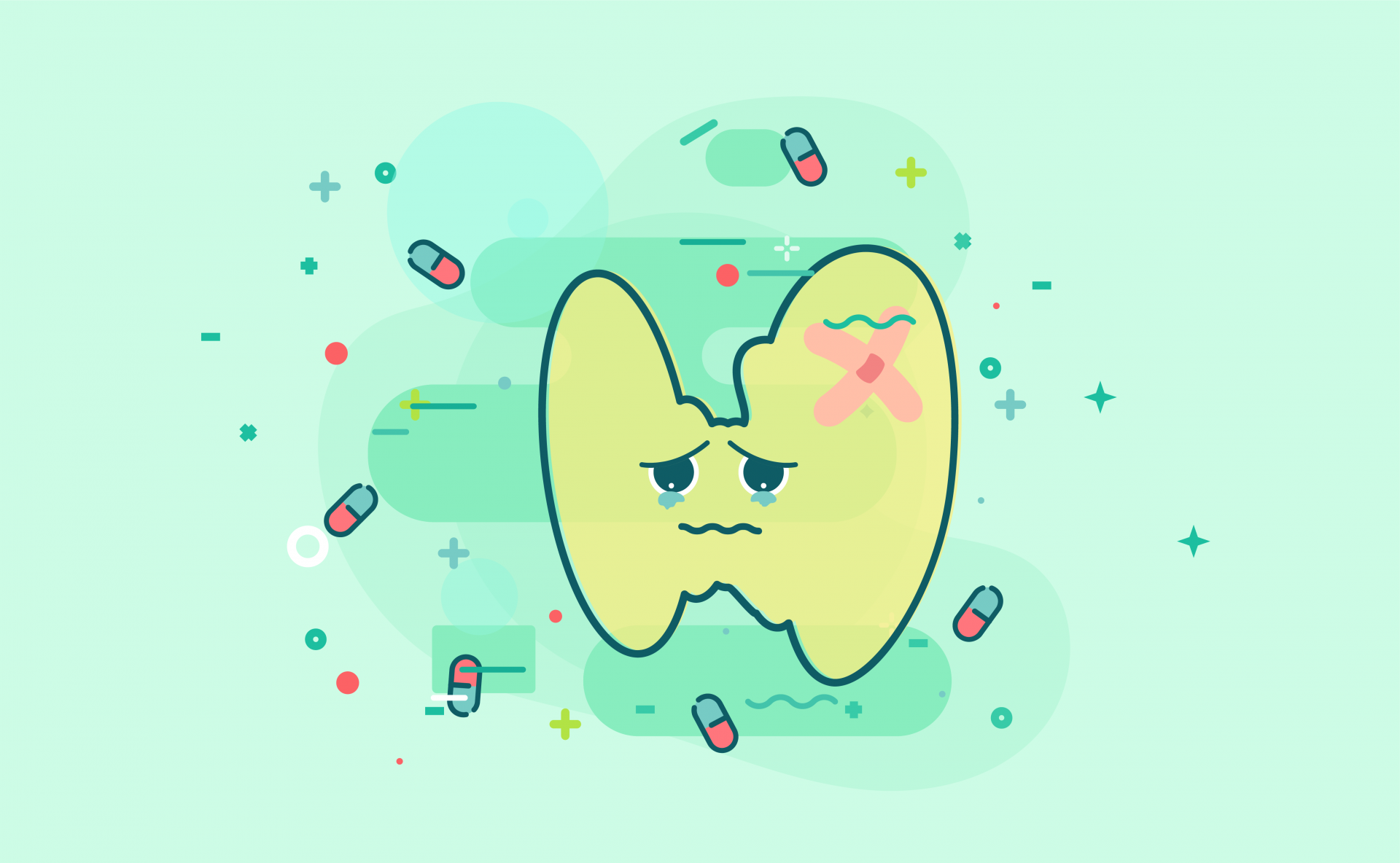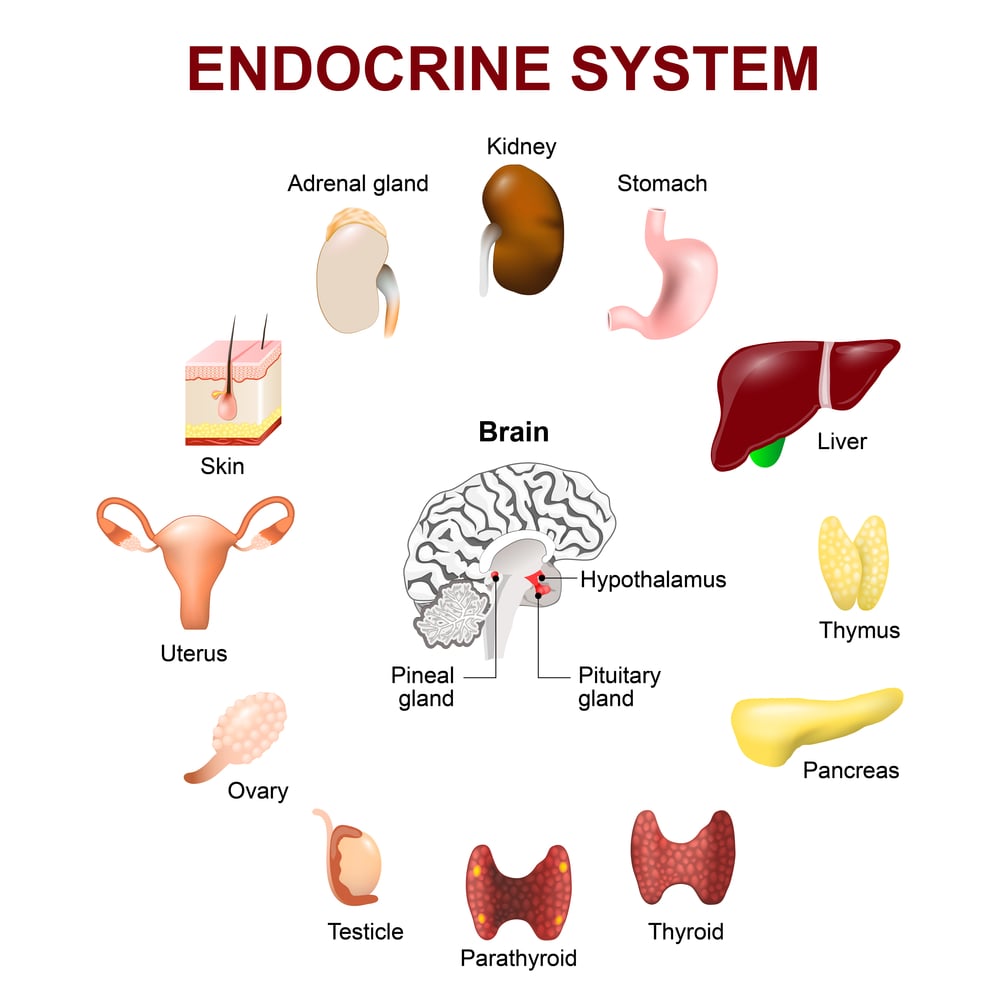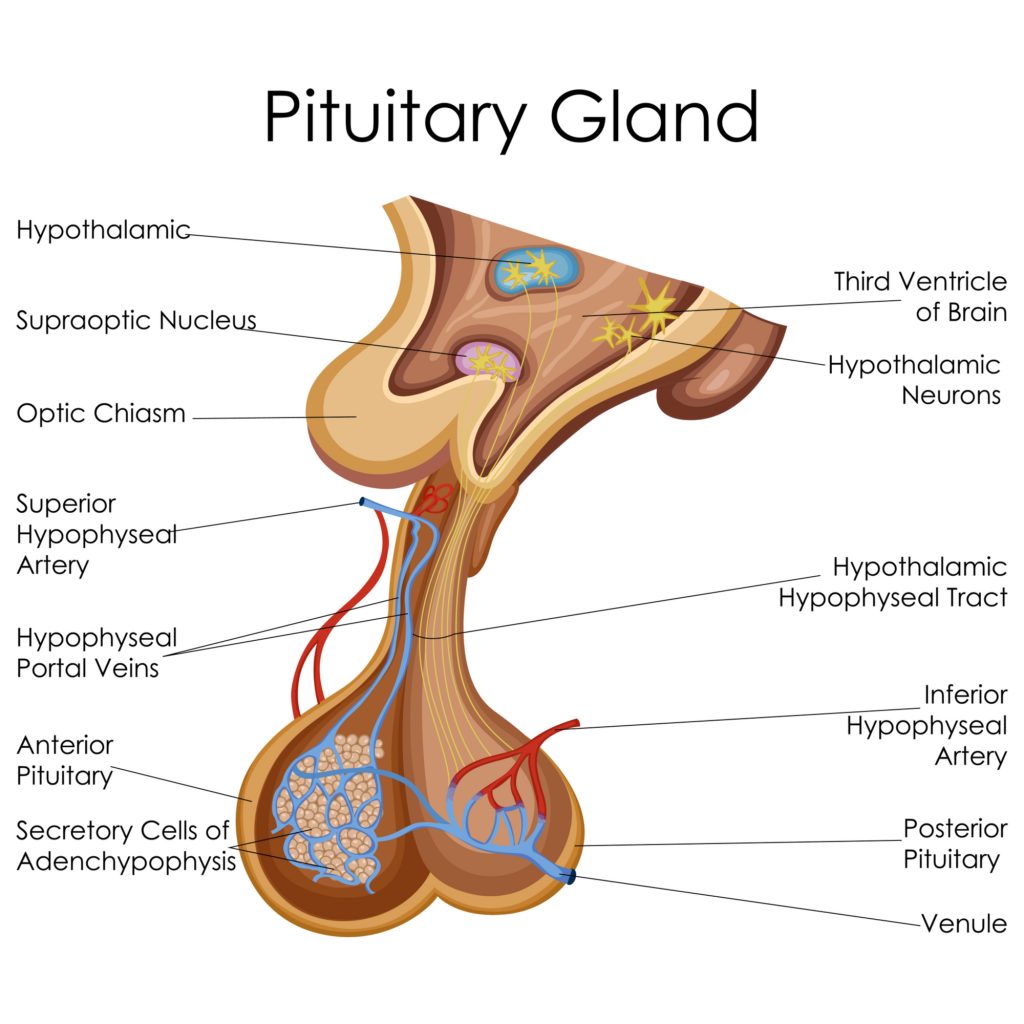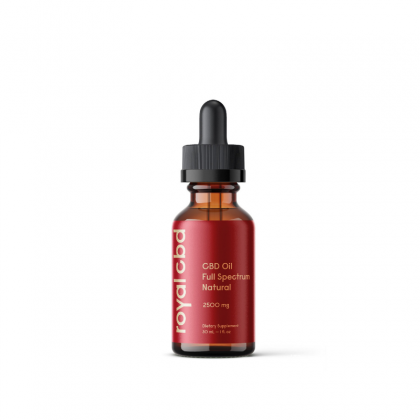| Total CBD: | 500 – 2500 mg |
| Potency: | 16.6 - 83.3 mg/mL |
| Cost per mg CBD: | $0.12 – $0.18 |
| Extract Type: | Full-spectrum |
| THC Content: | <0.3% |

Evidence based
CBD for Endocrine Disorders: Can CBD Oil Balance Hormones?
CBD targets a regulatory system in the brain that controls the balance of hormones.
Learn how doctors are using CBD to help patients with endocrine disorders.
The endocrine system is responsible for controlling everything from energy metabolism to reproductive health.
If there are any issues with this system, it can produce a range of uncomfortable, and often serious side effects.
CBD oil may be able to help.
It offers a wide range of supportive effects to this system and may be exactly what you need to get your body back on track.
Here, we discuss how CBD and the endocannabinoid system play a pivotal role in the endocrine system, and how it’s used for treatment.
Let’s get into it.
Best CBD Oils For Endocrine Disorders
- Royal CBD Oil — Best CBD Oil For Insulin Balance
- Gold Bee CBD Oil — Best CBD Oil For Metabolic Health
- Endoca CBD Oil — Best CBD Oil For Endocrine Health (Europe)
What Are The Benefits of CBD For The Endocrine System?
CBD is just one of about 80 different cannabinoids found in the cannabis plant. There are dozens of confirmed health benefits of CBD — many of which are helpful in supporting the health of the endocrine system.
These compounds are considered cannabinoids because of their ability to interact with a system in our body known as the endocannabinoid system.
The endocannabinoid system plays an important role in the body by maintaining homeostasis. This is often referred to as the body’s balance. Interestingly, this is also what the endocrine system does.
CBD and other cannabinoids may restore balance to this system directly through the hypothalamus and pituitary but also on the endocrine organs themselves.
The benefits of CBD oil for endocrine function includes:
- Supports insulin production
- Promotes weight loss
- Regulates metabolic function & blood sugar
- Supports mitochondrial health
- Regulates energy levels
- Reduces cortisol secretion
- Promotes digestive health
What Are Endocrine Disorders?
There’s a whole bunch of disorders that can result from a dysfunctional endocrine system. Some of them may seem unrelated to each other, but it’s important to note that the endocrine system is very widespread, and involves many different organs throughout the body, all working together.
Our endocrine system is very important for maintaining balance in the body. It regulates everything from energy metabolism to red blood cell production.
In healthy people, the endocrine system is in constant feedback with itself, turning on and off to keep our various body metrics at an even plane.
When the system falls out of balance, the system falls apart, and we suffer health problems, some of which are more severe than others.
- Diabetes — poor insulin production or function leading to high blood sugar levels
- Metabolic syndrome — involves dysfunctional sugar and fat metabolism
- Fatty liver disease — a buildup of fatty acids in the liver
- Osteoporosis — poor bone metabolism leading to low bone density
- Hashimoto’s thyroiditis — an autoimmune disorder that attacks the thyroid gland
- Cushing’s syndrome — an autoimmune disorder affecting the adrenal glands
- Grave’s disease — an autoimmune disorder affecting the thyroid gland
- Addison’s disease — involves poor adrenal gland function
- Goiters — low iodine causing an enlargement of the thyroid gland
- Hyperglycemia — high blood sugar levels
- Hyperparathyroidism — excessive parathyroid function
- Hypoglycemia — low blood sugar levels
- Menopause — an age-related change in female hormone balance
- Obesity — excess storage of sugars and fats
- Polycystic ovarian syndrome (PCOS) — involves a combination of androgen and insulin dysfunction
What is The Endocrine System?
Before we start, we’ll get into a basic understanding of how the endocrine system works.
The endocrine system is made up of a team of various glands found throughout the body, working together to keep the body in balance (homeostasis).
These glands secrete hormones to communicate with the rest of the body.

You can think of the endocrine system as a company.
The CEO is the hypothalamus, found in the center of the brain. It looks at the organization as a whole and decides where to make changes in the plan to make sure the company—our body—stays on track.
Just like the CEO of a company, the hypothalamus doesn’t make any of these changes itself. Rather, it delegates the roles to different departments, made up of other executive organs such as the pancreas, adrenal glands, thyroid, and others.
Each of these glands serves as the head of a particular department—Some control energy metabolism, growth, immune function, body temperature, or bone structure.
When the hypothalamus instructs, they then turn to their own teams of various hormones and neurotransmitters. It’s these workers that actually carry through the changes initiated by the hypothalamus.
This system is in constant feedback with itself, constantly checking to see how these changes are implemented, and what their effect produces.
The Endocrine Glands 101
There are 9 main endocrine glands in the body. Each one is considered an executive, with a particular area of specialization, all of which respond directly to the hypothalamus (the CEO).
Here, we’ll go into detail for each one, highlight some of the common endocrine disorders that can result, and how CBD and other cannabinoids are used to improve the function of these organs/glands.
1. Pineal Gland
The pineal gland is responsible for controlling sleepiness.
It gathers information from other areas of the brain that measure the visible light spectrum. It’s designed to react to changes in daylight from blue-light to red-light.
Red light waves are associated with early morning and late afternoon when the sun rises and sets. The angle of the sun shining through the atmosphere reflects the blue light waves, allowing the more penetrating red light waves to make it through.
This helps us recognize when we should feel sleepy at night.
Blue light only makes it through the atmosphere when the sun is directly facing us. This is the light we see during the day, which the pineal gland determines to be the time when we should be wide awake.
When the pineal gland only senses red light, it releases the sleep hormone melatonin. If this is interrupted with blue light, melatonin secretion slows down, making it difficult for us to fall asleep.
The effects of blue and red light waves are well-documented. large electronics manufacturers such as Apple have started incorporating this into their design. Many computer screens now have a blue-light filter to prevent the blue light from activating the pineal gland and affecting sleep when working into the evenings.
Side-Effects of Pineal Dysfunction:
- Mood disorders
- Jetlag
- Insomnia
2. Hypothalamus
The hypothalamus is the CEO of the endocrine system.
It’s responsible for controlling the majority of the endocrine system’s function by delegating to the organs what to do.
Functions Regulated by the Hypothalamus:
- Body temperature
- Thirst and appetite
- Weight control
- Emotion
- Sleep cycles
- Libido
- Childbirth and reproductive health
- Blood pressure
- Heart rate
- Digestive function
If there’s a problem with the hypothalamus, it can cause problems with any of the other parts of the endocrine systems.
Dysfunctions of the hypothalamus can result in the following conditions:
- Hypopituitarism
- Neurogenic diabetes insipidus
- Hypothyroidism
- Hyperthyroidism
- Eating disorders
3. Pituitary Gland
If the hypothalamus is the CEO, then the pituitary gland is the vice president.
It listens to messages sent from the hypothalamus and carries this message to other endocrine glands through the secretion of hormones.
Pituitary Hormones Include:
- Thyroid-stimulating hormone (TSH)
- Luteinizing hormone (LH)
- Follicle-stimulating hormone (FSH)
- Prolactin (PRL)
- Growth Hormone (GH)
- Melanocyte-stimulating hormone (MSH)
- Adrenocorticotropic hormone (ACTH)
If there’s an issue with the pituitary, it can cause problems at the organ level.
Side-Effects of Dysfunctional Pituitary Gland:
- Chronic fatigue syndrome
- Low libido
- Headaches
- Menstrual irregularities
- Infertility
- Erectile dysfunction
- Cushing’s syndrome
- Depression

4. Thyroid Gland
The thyroid gland is responsible for controlling our metabolism.
The pituitary receives information from the hypothalamus, which it then forwards to the thyroid gland.
Using hormones, it directs the thyroid to either speed up or slow down.
In this way, the thyroid essentially controls how we use energy throughout the body.
The thyroid can increase metabolism to burn through more energy, generate more internal body heat, or burn excess fat.
It can also slow down to conserve energy and help us cool down in hot weather by avoiding excess heat production as a byproduct of metabolism.
There are two main issues that can arise with dysfunctional thyroid glands; hypothyroidism and hyperthyroidism.
In hypothyroidism, we don’t metabolize enough, everything slows down, and we become fatigued and tired. It also becomes easier to gain excess weight than to burn it.
In hyperthyroidism, we’re metabolizing too quickly. We can develop anxiety, insomnia, diarrhea, and heart palpitations as a result. It becomes easier to lose weight than to gain it with this condition.

5. Parathyroid Glands
The parathyroids are small glands that sit behind the thyroid. They control our calcium balance in the body and therefore play a significant role in maintaining blood pH homeostasis, calcium, phosphorus, and bone metabolism.
Just like the thyroid, there are two main issues that can result from dysfunctional parathyroids; hypoparathyroidism and hyperparathyroidism.
Hypoparathyroidism shifts the balance of calcium and phosphorous and can lead to long-term problems with the cardiovascular system and the nervous system. It causes calcium levels to drop and phosphorous levels to rise above healthy levels.
Hyperparathyroidism is a serious condition. It causes calcium levels to rise, resulting in osteoporosis, joint pain, kidney stones, and low immune function.
6. Thymus Gland
The thymus is the college for the immune system. It’s where immune cells such as T-lymphocytes go to mature.
The immune and blood cells are first made in the bone marrow, before traveling to the thymus where they are conditioned as trained assassins for the immune system.
Problems with the thymus can affect our immune function and are one of the main causes of autoimmune conditions such as myasthenia gravis and rheumatoid arthritis.
In these diseases, the immune cells are taught to attack the body instead of invading pathogens, leading to targeted joint or tissue damage in the body by our own immune cells.
7. Adrenals
The adrenal glands are responsible for everything from blood pressure to heart rate. Hormones produced by these glands include cortisol or cortisone. These hormones control our stress levels through the fight-or-flight response.
The adrenals also control our energy levels throughout the day and help regulate sexual function.
Problems of the adrenal glands include:
- Cushing’s disease
- Chronic fatigue syndrome
- Fibromyalgia
- Anxiety
- Insomnia
8. Pancreas
The pancreas is responsible for controlling our blood glucose levels through the hormones insulin and glucagon.
Insulin is important for moving sugars from the blood into the cells where they are used to power the cells. Glucagon is used to break down stored sugars to ensure the body has enough energy to function.
These two hormones require careful measurement and balance by the hypothalamus, or they can result in serious problems. Too much sugar can damage organs, while not enough sugar leaves us feeling tired, confused, and dizzy.
The pancreas is also responsible for producing many of the enzymes we use to break down our food.
Dysfunctions of the pancreas can lead to problems such as:
- Diabetes (type 1 or 2)
- Metabolic syndrome
- Fatty liver disease
- Indigestion
- Weakness
- Hypoglycemia
- Polycystic ovarian syndrome
9. Testes & Ovaries
Last, but not least, we have the gonads. These are the sex organs of the human body.
They release hormones that control everything from growth habits, immune function, sexual health, and mood.
Both of these organs respond to hormones released by the pituitary to control their function.
Dysfunctional testes/ovaries can lead to conditions such as:
Men (Testes)
- Low libido
- Erectile dysfunction
- Infertility
- Low immunity
- Prostatitis
- Muscle wasting
- Fatigue
- Heart disease
Women (Ovaries)
- Menstrual irregularities
- Polycystic ovarian syndrome
- Infertility
- Menopause
- Low immunity
- Hirsutism (irregular hair growth)
- Chronic fatigue syndrome
- Low blood pressure
- Anemia
Common Treatments for Endocrine Disorders
Endocrine disorder treatment usually involves either inhibiting or promoting hormone production. While this sounds straightforward and relatively harmless, many adverse effects come with these drugs.
Treatments vary depending on the specific issue, but medications tend to fall into the following categories.
- Pituitary and hypothalamic hormone drugs (bromocriptine, lanreotide, somatropin, pasireotide)
- Somatostatins (octreotide, lanreotide, vapreotide)
- Dopamine and dopamine agonists (bromocriptine, cabergoline, pergolide)
- Somatropin and somatropin agonists (mecasermin, pegvisomant)
- Vasopressin and vasopressin agonists (desmopressin, tolvaptan, conivaptan)
- Thyroid and antithyroid agents (teriparatide, levothyroxine sodium, potassium perchlorate, metimazole, thiamazole)
- Insulin and noninsulin glucose lowering drugs (metformin, lispro, aspart, nateglinide)
Using CBD for Endocrine Disorders
CBD works directly through the CEO, the hypothalamus.
It acts as a business strategist, helping the hypothalamus do its job better than ever.
This has a trickle-down effect on the rest of the endocrine system organs, offering broad, but powerful benefits towards maintaining homeostasis in the body.
CBD May Be Able to Support Endocrine Disorders Such as:
- Diabetes
- Reproductive health
- Thyroid disorders
- Adrenal disorders
- Stunted growth
- Lactation
- Mood disorders
Because of its ability to improve the function of the hypothalamus, rather than push it in one direction or another, it’s useful for restoring homeostasis overall.
This helps to repair conditions that involve dysfunction in both directions:
1. Metabolic Excess:
- Hyperthyroid (Excess thyroid activity)
- Hyperparathyroid (Excess parathyroid activity)
- Hyperadrenalism (Excess adrenal activity)
2. Metabolic Deficiency:
- Hypothyroidism (Deficient thyroid activity)
- Hypoparathyroidism (Deficient functioning parathyroid activity)
- Hypoadrenalism (Deficient adrenal activity)
Therefore using CBD oil for endocrine disorders is simple. Once you’ve found the right dose, you just keep taking the oil as conditions gradually improve.
Of course, as with any other medical condition, it’s important that you’re taking other measures to treat the condition. There are some medications that interact with CBD; never combine them or stop taking any medication in substitution for CBD oil without first speaking with your doctor.
Many of these conditions are chronic in nature (long-term and self-sustaining). Therefore, it’s likely that it will take a few weeks to a few months before you start to see noticeable benefits from supplementing with CBD oil.
You’re essentially toning the hypothalamus when taking CBD oil. You won’t see immediate changes from the benefits of CBD oil for these conditions. In some cases, CBD will never fully eradicate the problem.
Patience is key.
You most likely didn’t get sick overnight, so you can’t expect to get better overnight either.
Finding the Right Dose of CBD Oil for Endocrine Disorders
Whenever trying CBD oil for the first time, it’s important to start small and increase the dose gradually.
Even though hemp-derived CBD oil is non-psychoactive, it affects everybody differently.
Some people need large doses, in the realm of 40mg per day, while others need very small doses, around 2 mg per day.
Finding the right dose takes trial and error.
You should start with a small dose and add 2 or 3 mg per day.
You’ll know you found the right dose when you start to feel symptoms disappear OR after you experience some side effects. When this happens, you’ve found your upper limit and should lower the dose to the last one that didn’t produce side effects.
References Cited in This Article
- Koch, M., Dehghani, F., Habazettl, I., Schomerus, C., & Korf, H. W. (2006). Cannabinoids attenuate norepinephrine‐induced melatonin biosynthesis in the rat pineal gland by reducing arylalkylamine N‐acetyltransferase activity without involvement of cannabinoid receptors. Journal of neurochemistry, 98(1), 267-278.
- Vemuri, V. K., Janero, D. R., & Makriyannis, A. (2008). Pharmacotherapeutic targeting of the endocannabinoid signaling system: drugs for obesity and the metabolic syndrome. Physiology & behavior, 93(4-5), 671-686.
- Brown, T. T., & Dobs, A. S. (2002). Endocrine effects of marijuana. The Journal of Clinical Pharmacology, 42(S1), 90S-96S.
CBD For Health & Wellness: Alphabetical
-
Conditions Related to Health Benefits
- CBD For Allergies: Can This Cannabinoid Ease Symptoms?
- Top 10 CBD Oils For Back Pain
- Can CBD Help With Menstrual Cramps?
- CBD for Sciatica: How It Works, Safety, Drug Interactions, & Best Products
- Is CBD a Viable Treatment for Cerebral Palsy?
- CBD Oil For Sleep
- CBD For Psoriasis: Can CBD Help to Alleviate Symptoms?
- Traumatic Brain Injury (TBI)
- Arthritis
- Anxiety & Depression
- Weight Loss
- ADD & ADHD
- Anorexia
- Alzheimer’s Disease & Dementia
- Addiction
- ALS (Amyotrophic Lateral Sclerosis)
- Antibiotic Resistance
- Asthma
- Atherosclerosis
- Autism
- Acne
- Bipolar Disorder
- Pain
- Crohn's Disease & Ulcerative Colitis
- Diabetes
- Epilepsy
- Endocrine Disorders
- Fibromyalgia
- Fatty Liver Disease
- Glaucoma
- Hypertension
- Heart Disease
- Huntington's Disease
- Inflammation
- Irritable Bowel Syndrome (IBS)
- Kidney Disease
- Migraine Headaches
- Muscle Recovery
- Multiple Sclerosis
- Motion Sickness
- Metabolic Syndrome
- Neurodegeneration
- Cancer
- Nausea
- Neuropathic (Nerve) Pain
- Osteoporosis/Bone Health
- Obsessive-Compulsive Disorder (OCD)
- Polycystic Ovarian Syndrome (PCOS)
- PTSD
- Prion/Mad Cow Disease
- Premenstrual Syndrome (PMS)
- Parkinson’s Disease
- Schizophrenia
- Sickle Cell Anemia
- Stroke
-
Conditions Related to Products
- Ranking The Top 13 THC Gummies By Category (Δ8, Δ9, Δ10, HHC, & More)
- Top 10 CBD Oils For Back Pain
- Everything You Need to Know About CBD Sunscreen
- Top 7 CBD Gummies For Sleep & Insomnia
- Top 7 CBD Gummies To Help With Anxiety (2022)
- Best CBD Gummies For Pain (Top-Rated Pain Gummies For 2022)
- Best Hemp Cigarettes (Top 5 Nicotine-Free Smokes)
- Top 5 CBD Lip Balms For 2022
- The Top 7 CBD Face Masks for 2022
- The Best CBD Inhalers For 2022 (& How to Use Them)
- Best Full-Spectrum CBD Vape Juice: What to Look For & How to Use It
- CBD Eye Drops: New Option For Glaucoma?
- CBD Oil For Dogs With Arthritis
- Best CBD Massage Oils In 2022
- Buyer's Guide To The Best CBD Vape Kits In 2022
- CBD Chocolate: Yes, It Exists & It's Just as Divine as it Sounds
- CBD Pre-Rolls & Cigarettes
- Terpene Concentrates
- Best CBD Soaps
- Best CBD Shampoo & Conditioner
- Best CBD Juul Pods
- CBD Isolate Oils
- Full-Spectrum CBD Oils
- Best CBD Lube
- CBD Honey
- CBD Transdermal Patches
- Best Dry Herb Vaporizers
- CBD Oil For Dogs With Epilepsy
- CBD Oil For Dogs With Anxiety
- CBD Oil For Dogs With Cancer
- CBD For Horses
- CBD Chewing Gum
- CBD Pain Cream
- CBD Oil For Cats
- CBD Oil For Dogs
- CBD Hemp Flower
- CBD Suppositories
- Best CBD Gummies for Pain, Sleep & Anxiety Reviewed (2022)
- CBD Teas
- CBD Vape Pens
- CBD Vape Oils
- CBD Coffee
- CBD Drinks & Shots
- CBD Crystals
- CBD Skincare
- Best CBD Oil & Gummies For Kids: Is CBD Safe for Children with Anxiety & ADHD?
- CBD Concentrates
- CBD Bath Bombs
- CBD Capsules
- CBD Sprays
- CBD Dog Treats
-
Conditions Related to Topicals
-
Conditions Related to Oils & Tinctures
-
Conditions Related to Edibles
- Top 7 CBD Gummies To Help With Anxiety (2022)
- Best CBD Gummies For Pain (Top-Rated Pain Gummies For 2022)
- CBD Chocolate: Yes, It Exists & It's Just as Divine as it Sounds
- CBD Honey
- CBD Chewing Gum
- Best CBD Gummies for Pain, Sleep & Anxiety Reviewed (2022)
- CBD Teas
- CBD Coffee
- CBD Drinks & Shots
- CBD Capsules
-
Conditions Related to Gummies
- Ranking The Top 13 THC Gummies By Category (Δ8, Δ9, Δ10, HHC, & More)
- Top 7 CBD Gummies For Sleep & Insomnia
- Top 7 CBD Gummies To Help With Anxiety (2022)
- Best CBD Gummies For Pain (Top-Rated Pain Gummies For 2022)
- Best CBD Gummies for Pain, Sleep & Anxiety Reviewed (2022)
- Best CBD Oil & Gummies For Kids: Is CBD Safe for Children with Anxiety & ADHD?
-
Conditions Related to Hemp Flower
-
-
Conditions Related to Terpenes
-
-
Conditions Related to Cultivation
-
Conditions Related to Concentrates
-
Conditions Related to Delta 8 THC
-
Conditions Related to Delta 9 THC
-
-
-
-
Conditions Related to CBD
- Everything You Need to Know About CBD Sunscreen
- Top 7 CBD Gummies For Sleep & Insomnia
- Top 7 CBD Gummies To Help With Anxiety (2022)
- Best CBD Gummies For Pain (Top-Rated Pain Gummies For 2022)
- Best Hemp Cigarettes (Top 5 Nicotine-Free Smokes)
- Top 5 CBD Lip Balms For 2022
- The Top 7 CBD Face Masks for 2022
- The Best CBD Inhalers For 2022 (& How to Use Them)
- Best Full-Spectrum CBD Vape Juice: What to Look For & How to Use It
- CBD Eye Drops: New Option For Glaucoma?
- CBD Oil For Dogs With Arthritis
- Best CBD Massage Oils In 2022
- Buyer's Guide To The Best CBD Vape Kits In 2022
- CBD Chocolate: Yes, It Exists & It's Just as Divine as it Sounds
- CBD Pre-Rolls & Cigarettes
- Best CBD Soaps
- Best CBD Shampoo & Conditioner
- Best CBD Juul Pods
- CBD Isolate Oils
- Full-Spectrum CBD Oils
- Best CBD Lube
- CBD Honey
- CBD Transdermal Patches
- CBD Oil For Dogs With Epilepsy
- CBD Oil For Dogs With Anxiety
- CBD Oil For Dogs With Cancer
- CBD For Horses
- CBD Chewing Gum
- CBD Pain Cream
- CBD Oil For Cats
- CBD Oil For Dogs
- CBD Hemp Flower
- CBD Suppositories
- Best CBD Gummies for Pain, Sleep & Anxiety Reviewed (2022)
- CBD Teas
- CBD Vape Pens
- CBD Vape Oils
- CBD Coffee
- CBD Drinks & Shots
- CBD Crystals
- CBD Skincare
- Best CBD Oil & Gummies For Kids: Is CBD Safe for Children with Anxiety & ADHD?
- CBD Concentrates
- CBD Bath Bombs
- CBD Capsules
- CBD Sprays
- CBD Dog Treats
-
-
Conditions Related to THC-O
-
-
Conditions Related to Joint Health
-
Conditions Related to Pain Disorders
- Top 10 CBD Oils For Back Pain
- Can CBD Help With Menstrual Cramps?
- CBD for Sciatica: How It Works, Safety, Drug Interactions, & Best Products
- Traumatic Brain Injury (TBI)
- Arthritis
- Pain
- Fibromyalgia
- Glaucoma
- Inflammation
- Kidney Disease
- Migraine Headaches
- Multiple Sclerosis
- Neuropathic (Nerve) Pain
- Premenstrual Syndrome (PMS)
- Sickle Cell Anemia
-
Conditions Related to Autoimmune Disease
-
Conditions Related to Cognitive Health
-
Conditions Related to Metabolic Disorders
-
Conditions Related to Psychological Disorders
-
Conditions Related to Muscles & Bones
-
Conditions Related to Nervous System
- CBD for Sciatica: How It Works, Safety, Drug Interactions, & Best Products
- Is CBD a Viable Treatment for Cerebral Palsy?
- CBD Oil For Sleep
- Traumatic Brain Injury (TBI)
- Anxiety & Depression
- ADD & ADHD
- Anorexia
- Alzheimer’s Disease & Dementia
- Addiction
- ALS (Amyotrophic Lateral Sclerosis)
- Autism
- Bipolar Disorder
- Epilepsy
- Huntington's Disease
- Inflammation
- Migraine Headaches
- Multiple Sclerosis
- Motion Sickness
- Neurodegeneration
- Neuropathic (Nerve) Pain
- Obsessive-Compulsive Disorder (OCD)
- PTSD
- Prion/Mad Cow Disease
- Parkinson’s Disease
- Schizophrenia
-
-
Conditions Related to Reproductive Health
-
Conditions Related to Hormones & Endocrine
-
Conditions Related to Skin Health
-
Conditions Related to Cardiovascular System
-
Conditions Related to Digestive System
-
Conditions Related to Genetic Disorders
-
Conditions Related to For Children











